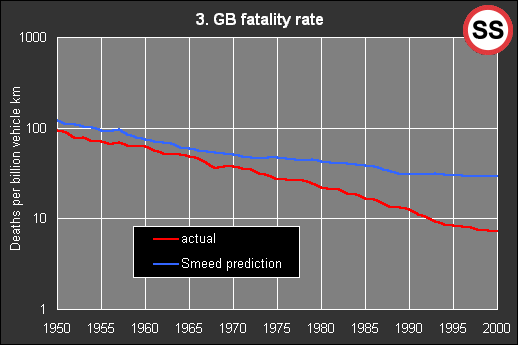That's:
"Famous People In Road Safety You've Never Heard Of"And to start - and probably end - the series, is
Reuben Smeed.
A recent conversation on the internet forum The Rev Counter was about improving safety levels, accident and casualty rates, and asked 'why?'
I've been involved in road safety for almost 30 years, so like to think I've had a bit to do with saving lives.
But what can I - or any other road safety professional - say to a theory which suggests that anything we do is almost irrelevant?

Read on:
http://en.wikipedia.org/wiki/Reuben_SmeedReuben Jacob Smeed (1909–1976) was a British statistician and transport researcher.
He obtained a degree in mathematics and PhD in aeronautical engineering from Queen Mary's College before entering academia as a teacher of mathematics.
When World War II started he was working for the Royal Aircraft Establishment on radio and radar equipment. In 1941 he assumed the rank of Wing Commander while he ran a small team in operations research for RAF Bomber Command looking at bomber losses. Whilst there he used statistics to verify the safest methods and formations for bombers and to investigate the effectiveness of various radar countermeasures, and by 1945 had become their Chief Research Officer.
In 1947 he joined the Traffic and Safety Division as Deputy Director at the Department of Scientific and Industrial Research (later the Transport Research Laboratory), where he investigated issues around traffic, road users, accidents, lighting and vehicle behaviour, pioneering the scientific study of transport studies. In so doing, he discovered a number of surprising or counter-intuitive features of road systems. In 1949 he proposed Smeed's law, an empirical rule that broke the usual link between environmental factors and road accidents. Instead he correlated traffic fatalities to traffic density, as measured by the proxy of motor vehicle registrations and country population. He also proposed that the average speed of traffic in central London would always be nine miles per hour, because that is the minimum speed that people will tolerate. He claimed that his new designs for the linked use of traffic lights might increase the number of cars on the roads but would not increase their speed, because, as soon as the traffic flowed faster, more drivers would come to slow it down. Under his direction the TRL investigated many aspects of road safety and driver behaviour, publishing more than 50 papers.
http://en.wikipedia.org/wiki/Smeed's_lawincreasing traffic volume leads to a decrease in accidents per vehicle. It was posited after an analysis of figures from a number of countries over several decades.
[Wiki has a theorem or two here, but it won’t C&P]
Smeed published his research for 20 different countries, and by his death he had expanded this to 46 countries, all showing this result. Smeed became deputy director of the Road Research Laboratory and later Professor at University College London.
The relationship was revisited by John Adams who held that it was valid for a variety of countries over time, for example in Great Britain from 1909 to 1973. In 1995 Adams further showed the relationship worked for the data of 62 countries. He noted the enormous difference in fatality rates across different parts of the world even though vehicles may be built to approximately similar standards, which, according to the theory, is "explained by myriad behavioural adjustments in response to perceived increases in the threat of traffic".
However, the validity of Smeed's Law has also been disputed by several other authors (for example Andreassen, Broughton, Oppe, Ameen & Naji).
Smeed himself took his law as expressing a truth about group psychology: people would take advantage of improvements in automobiles or infrastructure to drive ever more recklessly in the interests of speed until deaths rose to a socially unacceptable level, at which point safety would become more important and recklessness less tolerated.
Freeman Dyson summarized his friend's view as:
Smeed had a fatalistic view of traffic flow. He said that the average speed of traffic in central London would always be nine miles per hour, because that is the minimum speed that people will tolerate. Intelligent use of traffic lights might increase the number of cars on the roads but would not increase their speed. As soon as the traffic flowed faster, more drivers would come to slow it down.....Smeed interpreted his law as a law of human nature. The number of deaths is determined mainly by psychological factors that are independent of material circumstances. People will drive recklessly until the number of deaths reaches the maximum they can tolerate. When the number exceeds that limit, they drive more carefully. Smeed's Law merely defines the number of deaths that we find psychologically tolerable.
Whilst in charge of the RRL's traffic and safety division, Smeed's views on speeds and accidents were well reported at the time of the introduction of a mandatory speed limit on UK roads: "If I wanted to stop all road accidents I would ban the car and introduce an overall speed limit, for there is no doubt that speed limits reduce accidents. Of course, roads with higher speeds often have lower accident rates. It is only on the safer, clear roads that you can drive fast - but that does not prove that you are driving more safely". He recognised that few methods of reducing accidents were painless and thus preferred to report facts and not to make direct recommendations as: "political, social and economic factors come in - but the people who make the decisions must know what the facts are on a subject.".
http://www.safespeed.org.uk/smeed.htmlWritten by the late Paul Smith, notes how Smeed should be nowadays in the UK, and postulates why not.
Oh, I couldn't find a picture of him, so
this'll have to do :)
.





